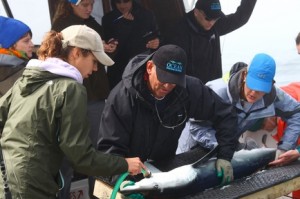New funding for shark research in Nova Scotian waters
News Release
Dalhousie University
31. July 2013
——————
Dalhousie University’s Ocean Tracking Network (OTN) has been awarded funding from Encana Corporation to study blue sharks off the coast of Nova Scotia, and to train students in the capture, tagging and tracking of marine animals over the next two years.
Key Points:
-
 The work will see forty juvenile blue sharks acoustically tagged to monitor their movements and habitat use. Tags emit a coded signal that is picked up and stored by acoustic receivers anchored on the ocean floor or on infrastructure. The signal—corresponding to individual animals’ species, size, tagging location, and detection time and location—is offloaded from the receivers at regular intervals and used to create comprehensive maps of movements, migrations and habitat use.
The work will see forty juvenile blue sharks acoustically tagged to monitor their movements and habitat use. Tags emit a coded signal that is picked up and stored by acoustic receivers anchored on the ocean floor or on infrastructure. The signal—corresponding to individual animals’ species, size, tagging location, and detection time and location—is offloaded from the receivers at regular intervals and used to create comprehensive maps of movements, migrations and habitat use. - Top-level predators are important indicators of ecosystem health. Many shark species are approaching endangered-species status due to the international shark fin trade and their frequency as commercial bycatch. Blue sharks are one of the most common species to occur in Nova Scotia waters, yet their residence and movements in here are poorly documented.
- The Encana funding of $50.8K is from the Deep Panuke Education & Training and Research & Development, and was awarded to OTN as an outcome of a recent research call for proposals. Encana is the owner and operator of the Deep Panuke natural gas project in Nova Scotia’s offshore.
- The OTN research also expands on existing acoustic telemetry coverage in the region by mounting new receivers on oceanographic and monitoring infrastructure used by the offshore oil and gas industry in the region. The new units will complement the area’s existing acoustic arrays, permitting more precise measurement of the habitats used by sharks and other species. Acoustic receiver coverage in the region includes the world’s most extensive telemetry array off of Halifax. This array, operated by OTN, spans the width of the continental shelf to a distance of 100 nautical miles offshore. Additional regional arrays are present in the Cabot Strait and in the Bay of Fundy.
- Canadian and international scientists have also been acoustically tagging other important marine species moving along the North American east coast. These include highly migratory species such as Great White sharks, Bluefin tuna, Atlantic sturgeon, and Atlantic salmon as well as groundfish like Atlantic cod.
Pull Quotes:
- “Tagging juveniles could help us locate a nursery in the region and figure out if the nursing ground and behaviours are being unintentionally affected by human activity.” – Brendal Davis, biologist for the shark tagging component of the grant.
- “If we are to maintain the health of ocean ecosystems, we have got to take care of the top predators. The unique partnership of this project is enabling research that will help us understand the needs of these animals, and ensure a future for them. We are grateful to all who are assisting.” – OTN executive director Fred Whoriskey.
Source and Photo Credit: Dalhousie University – Media Centre
Related Video, uploaded by webeditors1 on 31. July 2013 :
Dalhousie shark tagging –
Catching a shark, 9 nautical miles off Sambro Island
